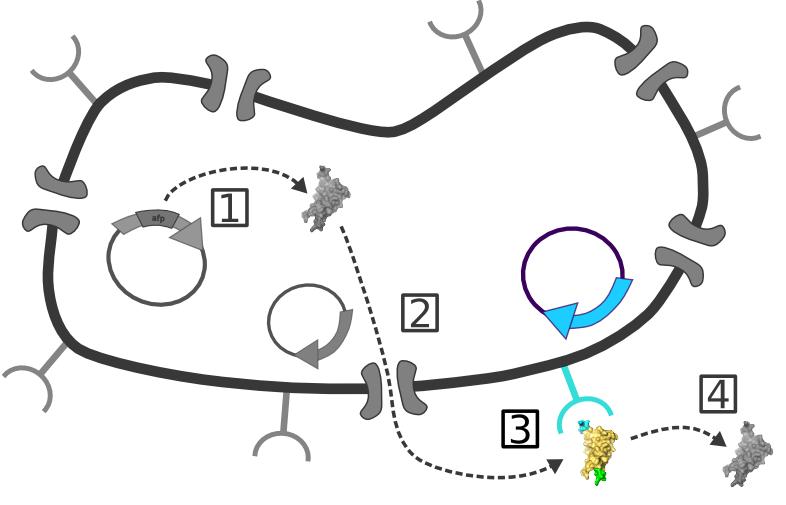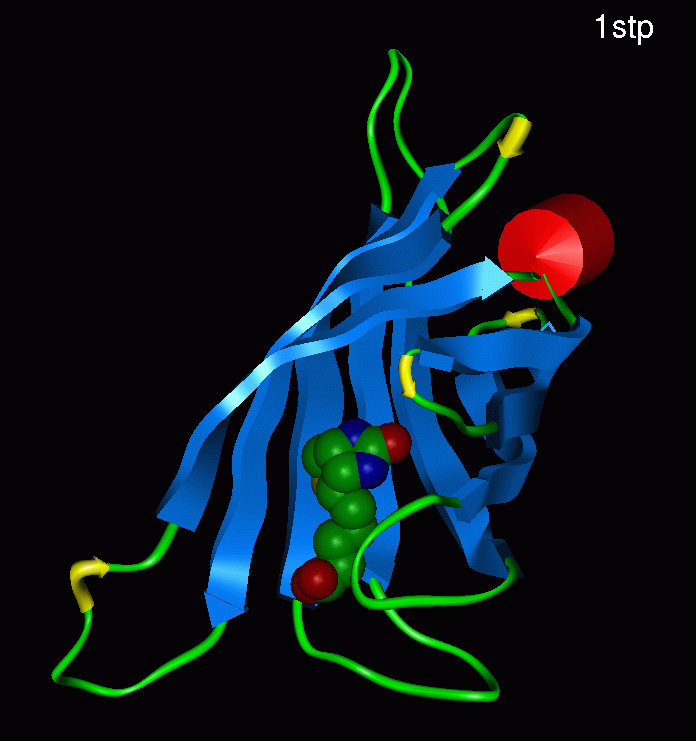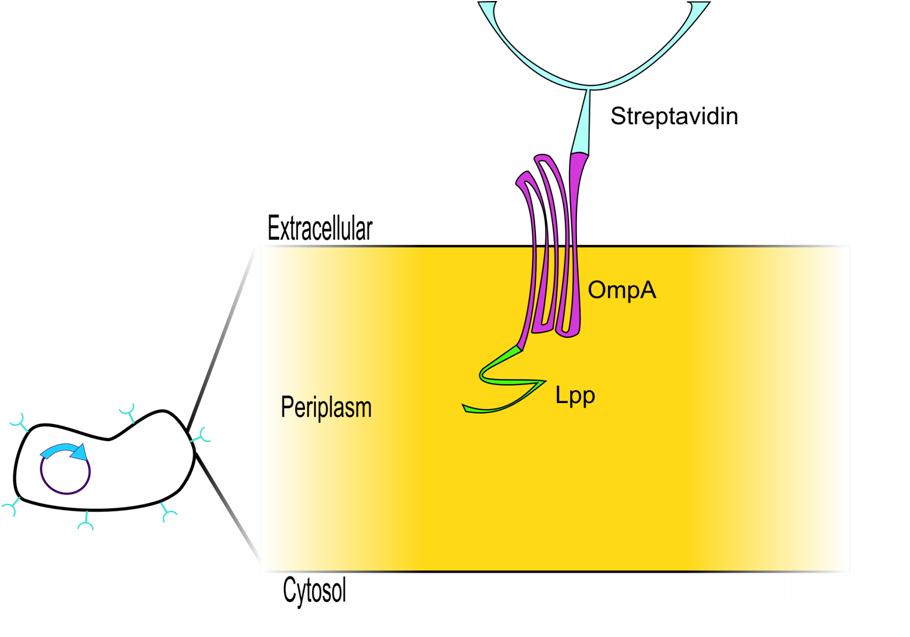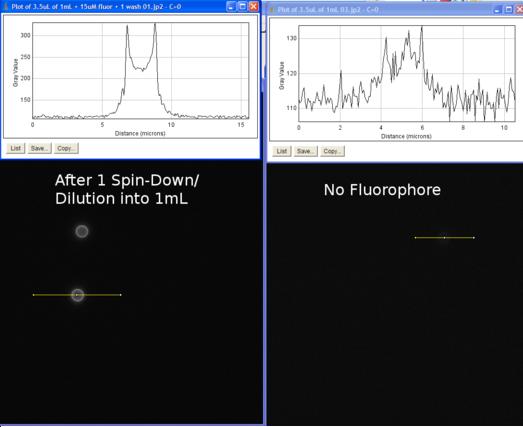Team:Washington/Project/Display
From 2009.igem.org
| Line 2: | Line 2: | ||
{{Template:Team:Washington/Templates/Header}} | {{Template:Team:Washington/Templates/Header}} | ||
| - | = | + | =Display System= |
[[Image:Titlepic.jpg]] | [[Image:Titlepic.jpg]] | ||
Revision as of 21:16, 13 October 2009
Display System
Background
Our system hinged on finding a protein which could bind other protines to the outside of the cell, but whose interaction with these proteins was weak enough to be disrupted by another small molecule. Streptavadin presented itself as a logical choice because it can bind biotin (a small molecule) as well as a nanotag sequence which can be added easily to any protein sequence [1]. The strepatavadin biotin complex is shown below.
- Image from Fritz Lipmann Institute (http://www.imb-jena.de/image_library/PROTEINS/proteins/1stp/)
Overview of strptavadin biotin binding [2].
Next we needed a way to anchor the streptavadin to the outer membrane. The obvious choice was to use the LPP signal peptide and Outer Membrane A (ompA) because it has been extensively studied. This LPP-ompA system has been used to display the following proteins:
- Green Fluorescent Protein (GFP) [3]
- Organophosphorus Hydrolase (OPH) [4]
- Cyclodextrin Glucanotransferase (CGTase) [5]
- Methyl Parathion Hydrolase (MPH) [6]
- Enhanced Green Fluorescent Protein (EGFP) [6]
Now we knew what we wanted. The next step was to check the parts registry to see if someone had already built this part, or anything similar that we could use as a starting part for our Idealized Protein Purification system. Low and behold this system was already in the parts registry, and it was submitted by Harvard in 2006 [7]. In fact Harvard had submitted four biobrick parts which where of interest to us. They used a They submitted four biobricks which where all variations on the same theme. All four are fusion proteins which have a LPP signal peptide, either one or five trans-membrane ompA, and either monomeric or dimeric streptavidin. All the variations and the resulting biobricks are shown below.
| Bio Brick | OmpA trans-membrane domains | Type of Streptavadin |
|---|---|---|
| J36848 | 1 | monomeric |
| J36849 | 1 | dimeric |
| J36850 | 5 | monomeric |
| J36851 | 5 | dimeric |
A basic graphic of the structure of this display system is shown below:
Now we had the parts that we wanted. After looking at the work Harvard did on these parts, we decided to do the following set of tests.
- Western against the his tags on all of these proteins
- Micrscope Assay
- Flow Cytometry Assay
Experiments
Western
The goal of this experiment was to make sure that the proteins were being expressed in our cell lines, and also to make sure that they were the correct length. This was crucial to ascertain before we moved on and began to test the parts. Even though we had the individual parts sequenced confirmed we needed to make sure that the proteins were being expressed correctly in the cell. Since all our the Harvard parts are conveniently his tagged this means that we could use a his tag antibody to detect the presence of these proteins in our western [8].
Results
File:Western.jpg Waiting for image from Ingrid
The expected values of each of these proteins are shown in the table below:
| Bio Brick | Length (in kD) |
|---|---|
| J36848 | 21478.7 |
| J36849 | 34600.9 |
| J36850 | 31215.4 |
| J36851 | 44972.3 |
This data showed that indeed our parts did come out at the expected lengths. The varying brightness of the bands does not indicate the strength of expression because the protein amount was not normalized before it was inserted into the gel. This was an important conclusion, which proved to us that these proteins were indeed being expressed by the cell. Now we could move on to check to see if the proteins were being expressed on the surface, and if they were functional. To do this we did a microscope assay.
Microscope Assay
The goal of this experiment was to see if we could confirm the presence of streptavadin on the outside of our cell. We wanted to do this using a biotyntalated flourophore. We expected that this flourophore would bind to the streptavadin on the outside of the cell in such a high level that we would be able to detect it under a high powered florescence microscope. The resulting concentration of florescence if high enough, would result in a halo of florescence around the cells. As a positive control we used streptavadin coated beads which were roughly the same size (with respect to volume) as our cells (except spherical).
Data
These images were analyzed using imageJ [9]. The image on the right shows an image of the beads with flourophore added to them. These beads were diluted and spun diluted and spun down until the background level of florescence was low enough to get an accurate reading. We then used imageJ to analyze the intensity of a line going through the bead. On the positive control the edges of the beads show spikes in florescence, which is what we expected. The negative control (beads without florophore) showed no such increase. This meant that our biotyntalated flouophore was working. Unfortunate when our cells were measured in the same manner, no difference could be seen between the induced (left) and the uninduced (right). However, this assay only looked at single cells and their binding properties. Before we could dismiss this part as not working, we need to take a look at a while population of cells. To do this was used flow cytomtery.
Flow Cytometry
The goal of this experiment was to see how the biotin bonded to streptavadin over a whole population of cells. Where as the Microscope experiment looked at a few localized cells, we set the cytometer to look 50,000 cells and read the resulting florescence. Our positive control was again the strepatavadin coated beads. The cytomtery would be able to read the flouresence of each individual particle passing through it, which would allow us to get much more accurate reading, and look at a much larger sample size than we could under the microscope. The results of this experiment are described below.
Data
Our positive control showed nice separation between the beads with flourophore and the beads without flourophore. This confirmed what we saw under the microscope, and also indicated that our assay was working. However this data showed us that we did not have any appreciable binding occurring with any of the ompA-sterptavadin parts to biotin at the global level. All our the cells have low levels of florescence which are comparable to those of the beads.
Conclusion
In conclusion we were able to shown that the proteins were being expressed in the cell by a western blot. We were unable however to see any sort of binding between the biotyntalated flourophore and the cells expressing these proteins. This meant that our display system was likely not binding biotin correctly. We hypothesized this could have been do to streptavadin not having enough room to form tetrameters on the surface (which is its native state)[10]. We came up with the following solutions to this problem.
Solutions
Fold It
New Display Constructs
References
- TBA
- TBA
- Display of green fluorescent protein on Escherichia coli cell surface. Shi H, Wen Su W. Department of Biological & Agricultural Engineering, University of Missouri-Columbia, 65211, Columbia, MO, USAEnzyme Microb Technol. 2001 Jan 2;28(1):25-34.
- Cell surface display of organophosphorus hydrolase using ice nucleation protein. Shimazu M, Mulchandani A, Chen W. Biotechnol Prog. 2001 Jan-Feb;17(1):76-80. Department of Chemical and Environmental Engineering, and Environmental Toxicology Program, University of California, Riverside, CA 92521, USA.
- Anchorage of cyclodextrin glucanotransferase on the outer membrane of Escherichia coli. Wan HM, Chang BY, Lin SC. Biotechnol Bioeng. 2002 Aug 20;79(4):457-64. Department of Chemical Engineering, National Chung Hsing University, Taichung, 402, Taiwan.
- Cell surface display of functional macromolecule fusions on Escherichia coli for development of an autofluorescent whole-cell biocatalyst. Yang C, Zhao Q, Liu Z, Li Q, Qiao C, Mulchandani A, Chen W. Environ Sci Technol. 2008 Aug 15;42(16):6105-10. State Key Laboratory of Integrated Management of Pest Insects and Rodents, Institute of Zoology, Chinese Academy of Sciences, Beijing 100101, China.
- Reference to Harvard's website from 2006
- http://www.kpl.com/catalog/productdetail.cfm?catalog_ID=17&Category_ID=448&Product_ID=1085
- http://rsbweb.nih.gov/ij/docs/index.html
- TBA
 "
"





